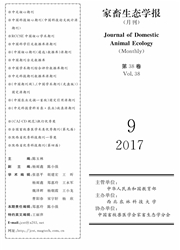

 中文摘要:
中文摘要:
Background: To explore the relationship between the heart-type fatty acid binding protein(H-FABP) gene and intramuscular fat(IMF), a polymorphism of the second exon of the H-FABP gene was investigated in 60 Three-yellow chickens(TYCs) and 60 Hetian-black chickens(HTBCs).Results: The IMF contents of the cardiac, chest and leg muscles in HTBC were increased compared with TYC. Both TYC and HTBC populations exhibited Hardy-Weinberg Equilibrium(HWE) according to the χ2test. Three variations of the two birds were detected, namely, G939 A, G982 A and C1014 T. HTBCs with the TT genotypes exhibit increased IMF content in the chest muscles compared with the TC genotype. Thus, the G982 A site could be considered a genetic marker for selecting increased IMF content in the chest muscles of HTBC. The correlation coefficients revealed that H-FABP m RNA expression was negatively correlated with the IMF content in the cardiac, chest and leg muscles of HTBC and in the cardiac and chest muscles of TYC. The relative m RNA expression of H-FABP was reduced in the cardiac and leg muscles of HTBC compared with TYC, but this difference was not observed at the protein level, as assessed by Western blot analysis.Conclusions: These findings offer essential data that can be useful in the breeding program of HTBC and future research exploring the role of H-FABP in IMF deposition and regulation in chickens.
 英文摘要:
英文摘要:
Background: To explore the relationship between the heart-type fatty acid binding protein(H-FABP) gene and intramuscular fat(IMF), a polymorphism of the second exon of the H-FABP gene was investigated in 60 Three-yellow chickens(TYCs) and 60 Hetian-black chickens(HTBCs).Results: The IMF contents of the cardiac, chest and leg muscles in HTBC were increased compared with TYC. Both TYC and HTBC populations exhibited Hardy-Weinberg Equilibrium(HWE) according to the χ2test. Three variations of the two birds were detected, namely, G939 A, G982 A and C1014 T. HTBCs with the TT genotypes exhibit increased IMF content in the chest muscles compared with the TC genotype. Thus, the G982 A site could be considered a genetic marker for selecting increased IMF content in the chest muscles of HTBC. The correlation coefficients revealed that H-FABP m RNA expression was negatively correlated with the IMF content in the cardiac, chest and leg muscles of HTBC and in the cardiac and chest muscles of TYC. The relative m RNA expression of H-FABP was reduced in the cardiac and leg muscles of HTBC compared with TYC, but this difference was not observed at the protein level, as assessed by Western blot analysis.Conclusions: These findings offer essential data that can be useful in the breeding program of HTBC and future research exploring the role of H-FABP in IMF deposition and regulation in chickens.
 同期刊论文项目
同期刊论文项目
 同项目期刊论文
同项目期刊论文
 Association of H-FABP gene polymorphisms with intramuscular fat content in Three-yellow chickens and
Association of H-FABP gene polymorphisms with intramuscular fat content in Three-yellow chickens and 期刊信息
期刊信息
